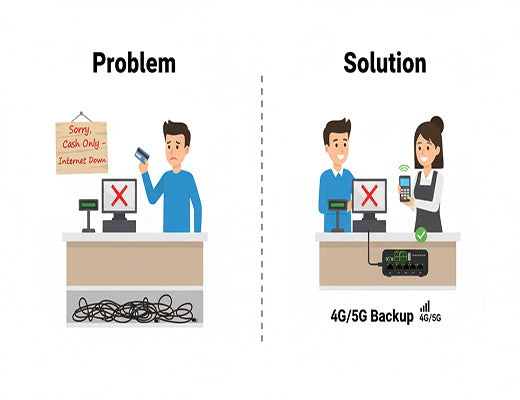
How to Use a Cellular Router for Retail & POS Network Backup
|
|
Time to read 4 min
|
|
Time to read 4 min
Using a cellular router for POS backup is one of the smartest and most cost-effective investments any retail business can make. This guide explains how this simple solution, known as WAN failover, automatically keeps your point-of-sale (POS) systems, credit card terminals, and other critical devices online when your primary wired internet connection fails, ensuring you never have to turn a customer away.
For a retail business, an internet outage means lost sales, frustrated customers, and a halt to operations.
A cellular router provides an immediate and automatic backup internet connection that is completely independent of your local cable or fiber provider.
The setup is simple: the router monitors your primary internet, and if it fails, it instantly switches all traffic to a 4G/5G cellular network.
This is a highly affordable "insurance policy" that protects your revenue and reputation for a small monthly cost.
I was at a busy coffee shop last week, and their internet went down right during the morning rush. The line of caffeine-deprived customers ground to a halt. The staff couldn't process any credit card payments. They had to frantically wave people away to a competitor across the street. I could almost see the dollar bills flying out the window.
Let's be clear: for any modern retail business, your internet connection is your cash register. When it goes down, you are closed for business.
The crazy part? This entire crisis is completely preventable. For a small investment, a simple cellular router for POS backup can make internet outages a complete non-event. This guide will show you exactly how.

Most businesses rely on a single, wired internet connection from a local cable or fiber provider. But what happens when that connection fails?
In any of these cases, the result is the same: your business goes offline. You can't process credit cards, your customer Wi-Fi dies, and your cloud-based inventory system is unreachable.
This is where a cellular router provides a simple and elegant solution. It acts as an automatic backup that kicks in the moment your primary internet goes down.
Here’s the step-by-step process:
The real 'aha!' moment for business owners is realizing that this entire process is 100% automatic. No one has to flip a switch or call IT. It just works.


You have insurance for fire, theft, and liability. A cellular router for POS backup is simply insurance for your revenue stream. In a world where connectivity equals commerce, it's the simple, affordable solution that ensures you're always open for business, no matter what happens to the internet connection outside your door.
Learn More in our main guide:
A1: Yes, absolutely. A standard 4G LTE connection provides more than enough speed to handle dozens of credit card transactions, POS system updates, and even basic guest Wi-Fi. You would only need a 5G backup for very high-traffic environments or if you are running many data-intensive applications.
A2: Very little. Since the cellular connection is only active during an outage, the data usage is typically very low. Most businesses can use a small, inexpensive M2M/IoT data plan. The automatic failback feature is key to ensuring you don't use cellular data unnecessarily.
A3: The physical setup is quite simple for anyone comfortable with basic network cables. The configuration of the failover rules can be done through a user-friendly web interface. For multi-location businesses, it's common to have an IT partner configure the devices and manage them remotely via a cloud platform.